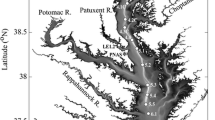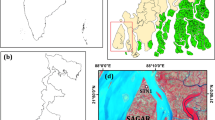Abstract
Long-term trends of bottom-water concentrations of dissolved oxygen (DO), total nitrogen, and total phosphorus at 42 sites in Tokyo Bay were analyzed using monthly data from 1983 to 2018 measured by local government agencies. The results were visualized as spatial distribution maps. Bottom-water DO concentrations varied seasonally. The area of hypoxic bottom water (DO < 2 mg L−1) was greatest in September of every year. Examination of interannual variations of the spatial distribution of bottom-water DO concentrations in September revealed that along the eastern side of the bay, hypoxic zones have been shrinking since the mid-2000s, but along the western side of the bay, the bottom water closest to shore is hypoxic in September even today. The areal percentage of hypoxic bottom water during September within inner Tokyo Bay has declined from 30% around 2007 to < 15% around 2015 and has not changed since then. A comparison of the spatial distributions of the frequencies of occurrence of red tides (chlorophyll-a concentrations ≥ 50 μg L−1) and hypoxic water masses during 8-year intervals revealed that areas with high percentages of red tides coincided with areas with high percentages of hypoxic bottom water. The implication is that the reduction of the size of the hypoxic zones along the eastern side of the bay was due to less frequent occurrence of red tides there. Reducing the inputs of nutrients to the bay as a result of policies aimed at reducing water pollution has, therefore, contributed to the mitigation of the hypoxia problem.















Similar content being viewed by others
References
Akaike H (1980) Likelihood and the Bayes procedure. Trabajos De Estadistica 31:143–166
Ando H, Kashiwagi N, Ninomiya K, Ogura H, Kawai T (2005) Changes in the state of water pollution in Tokyo Bay since 1980. Annu Rep Tokyo Metropolitan Research Institute for Environmental Protection, Tokyo, pp 141–150. https://www.tokyokankyo.jp/kankyoken_contents/report-news/2005/mizu-1.pdf. Accessed 21 July 2021 (in Japanese with English abstract)
Ando H, Wanami K, Ishii Y, Maki H (2015) Occurrence of hypoxic water in the coastal sea area of Tokyo Bay. Ann Rep Tokyo Metropolitan Research Institute for Environmental Protection, Tokyo, pp 40–41. https://www.tokyokankyo.jp/kankyoken_contents/cmsup/pdf/report2015_18.pdf. Accessed 21 July 2021 (in Japanese)
Bricker S, Longstaf B, Dennison W, Jones A, Boicourt K, Wicks C, Woerner J (2007) Efects of nutrient enrichment in the nation’s estuaries: a decade of change. NOAA Coastal Ocean Program Decision Analysis Series No. 26. National Centers for Coastal Ocean Science, Silver Spring, p 328. https://repository.library.noaa.gov/view/noaa/25526. Accessed 21 July 2021
Central Council for Environment (2015) Factors affecting water pollution, Report for the 8th Total Pollutant Load Reduction Comitte. https://www.env.go.jp/council/09water/y0917-06/mat05.pdf. Accessed 21 July 2021 (in Japanese)
Chiba Prefectural Government (2020) Water quality data base at each station in public waters. https://www.pref.chiba.lg.jp/suiho/kasentou/koukyouyousui/data/data_1.html. Accessed 21 July 2021 (in Japanese)
Chiba Prefectural Government, Environmental Department (1972–1998) Results of water quality measurement in public water bodies FY1971–1997 (in Japanese)
Fujiwara T (2002) Inflow of oceanic water into Tokyo Bay and generation of a subsurface hypoxic water mass. J Geophys Res 107(C5):13-1-13–9
Fujiwara T, Takahashi T, Yamada Y, Kaneko A (2000) Response of hypoxic water mass in Tokyo Bay to the variation in hydrographic condition outside of the bay. Oceanogr Jpn 9:303–313 (in Japanese with English abstract)
Furota T (1988) Effects of hypoxic water on benthic and attached animals in Tokyo Bay. Bull Coast Oceanogr 25:104–113 (in Japanese)
Hayashi T, Hasegawa K, Kajiyama M (2016) Relationships between nutrient concentration (DIN, DIP) and Color Tone of Nori Laver in Chiba Prefecture Futtsu Coastal Area. Bull Chiba Pref Fish Res Ctr 10:18–25 (in Japanese)
Hayashi T, Hasegawa K, Kajiyama M (2017) Relationships between nutrient concentration (DIN, DIP) and color tone of Nori Laver in Chiba Prefecture Kisarazu Coastal Area. Bull Chiba Pref Fish Res Ctr 11:31–37 (in Japanese)
Ishii M, Kato M (2005) Relationship between oxygen deficient water mass and catching point of Sea Bass Lateolabrax japonicus of small scale trawl in Tokyo Bay. Bull Chiba Pref Fish Res Cen 4:7–15 (in Japanese)
Japanese Standards Association (2016) 32.1 Iodometry, Testing methods for industrial wastewater, Japanese Industrial Standard, JIS K 0102:2016 (E):136-139
Kajiyama M (2019) Occurrence of Blue Tide and Fishery Damage in Tokyo Bay, Bull Chiba Pref Fish Res Ctr 13:61–76. https://agriknowledge.affrc.go.jp/RN/2010932241.pdf. Accessed 21 July 2021 (in Japanese)
Kanagawa Prefectural Government (2020) Kanagawa prefecture water quality survey chronology. http://www.pref.kanagawa.jp/docs/pf7/suisitu/joukyou.html. Accessed 21 July 2021 (in Japanese)
Kanagawa Prefectural Government, Environmental Department (1972–2009) Kanagawa prefecture water quality survey chronology FY1971–2008 (in Japanese)
Kashiwagi N, Ninomiya K, Ando H, Ogura H (2003) 3A Space-time state-space modelling of Tokyo Bay pollution. In: Ghosh AK, Ghosh JK, Mukhopadhyay B (eds) Sustainable environments: a statistical analysis. Oxford University Press, USA, pp 42–62. ISBN 019565858-2
Kodama K, Horiguchi T (2011) Effects of hypoxia on benthic organisms in Tokyo Bay, Japan; a review. Mar Pollut Bull 63:215–220
Kubo A, Hashihama F, Kanda J, Horimoto-Miyazaki N, Ishimaru T (2018) Long-term variability of nutrient and dissolved organic matter concentrations in Tokyo Bay between 1989 and 2015. Limnol Oceanogr 64:S209–S222
Maki H, Sekiguchi H, Hiwatari T, Koshikawa H, Kohata K, Watanabe M, Ando H, Kawai T, Yamazaki M (2011) Influence of storm water on the inner area of Tokyo Bay, vol 3. Fishery and oceanography in Tokyo Bay, pp 9–18. http://nrifs.fra.afrc.go.jp/publication/Tokyowan/PDF/Tokyowan-no-Gyogyo-to-Kankyo_no.3.pdf. Accessed 21 July 2021 (in Japanese)
Matsumura T, Ishimaru T (2004) Freshwater discharge and inflow loads of nitrogen and phosphorus to Tokyo Bay (from April 1997 to March 1999). Oceanogr Jpn 13:25–36 (in Japanese with English abstract)
Matsumura T, Ishimaru T, Imamura M (2004) Benthic of phosphorus and seasonal variation of oceanic structure in Tokyo Bay. Bull Coast Oceanogr 41:143–151 (in Japanese with English abstract)
Mee LD (2006) Reviving dead zones. Sci Am 295(5):78–85
Ministry of the Environment of Japan (2011) Guidance for introducing total pollutant load control system “TPLCS”. https://www.env.go.jp/en/water/ecs/pdf/english.pdf. Accessed 21 July 2021 (in Japanese)
Ministry of the Environment of Japan (2016) (Announcement) Revision of the public notice on the addition of environmental standards related to water pollution. https://www.env.go.jp/press/102287.html. Accessed 21 July 2021 (in Japanese)
Ministry of the Environment of Japan (2021) The wide-area comprehensive water quality survey, Comprehensive water environment information site. https://water-pub.env.go.jp/water-pub/mizu-site/mizu/download/download.asp. Accessed 21 July 2021
Nagao K, Hata K, Yoshikawa S, Hosoda M, Fujiwara T (2008) Biogeochemical model with benthic-pelagic coupling applied to Tokyo Bay. Annu J Coast Eng JSCE 55:1191–1195 (in Japanese with English abstract)
Nagashima H, Suzuki T (1996) Water circulation in Tokyo Bay. Bull Coast Oceanogr 34:37–44 (in Japanese with English abstract)
NIES: National Institute for Environmental Studies (2010) Hypoxia generation and its impact on benthic biota. Report of Special Research from the National Institute for Environmental Studies, SR-93-2010. https://www.nies.go.jp/kanko/tokubetu/pdf/sr93.pdf. Accessed 21 July 2021 (in Japanese)
Nihei Y, Ehara K, Usuda M, Sakai A, Shigeta K (2007) Water quality and pollutant load in the Edo River, Ara River and Tama River. Annu J Coast Eng JSCE 54:1226–1230 (in Japanese with English abstract)
Nihei Y, Ohtsuka S, Kageyama H, Hirose H (2008) Long-term trend of pollutant loads into Tokyo Bay. Annu J Coast Eng JSCE 55:1226–1230 (in Japanese with English abstract)
Nihei Y, Takioka K, Sakai A, Shigeta K (2009) Influences of large-scale flood on water quality of Tokyo Bay. J JSCE Ser B2 (Coast Eng) 65:1016–1020
Ninomiya K, Kashiwagi N, Ando H (1996a) Seasonal characteristics of spatial distributions of water temperature and salinity in Tokyo Bay. J Jpn Soc Water Environ 19:480–490 (in Japanese with English abstract)
Ninomiya K, Kashiwagi N, Ando H (1996b) Seasonal characteristics of spatial distributions of COD and DO in Tokyo Bay. J Jpn Soc Water Environ 19:741–748 (in Japanese with English abstract)
Ninomiya K, Kashiwagi N, Ando H, Ogura H (1997) Seasonal characteristics of spatial distributions of dissolved inorganic nitrogen and phosphorus in Tokyo Bay. J Jpn Soc Water Environ 20:457–467 (in Japanese with English abstract)
Sato C, Nakayama K, Furukawa K (2012) Contributions of wind and river effects on DO concentration in Tokyo Bay. Estuar Coast Shelf Sci 109:91–97
Suzuki K (2013) Efect of wind and fresh water discharge on water exchange and hypoxia in Tokyo Bay, vol 1276. Technical note of the port and airport research institute. https://www.pari.go.jp/search-pdf/no1276.pdf. Accessed 21 July 2021 (in Japanese with English abstract)
Suzuki K, Isobe M, Yoneyama H, Nakamura Y (2012) Effect of the clockwise circulation on the hypoxia at the head of Tokyo Bay. J JSCE Ser B2 (Coast Eng) 68:981–985 (in Japanese with English abstract)
Tada K, Fujiwara M, Honjo T (2010) Water quality and nori (Porphyra) culture in the Seto Inland Sea. Bunseki Kagaku 59(11):945–955 (in Japanese with English abstract)
Takao T, Okada T, Nakayama K, Furukawa K (2004) Seasonal variation of residence time of sea water in Tokyo Bay during 2002, vol 169. Technical note of national institute for land and infrastructure management, Montreal, Japan. http://www.nilim.go.jp/lab/bcg/siryou/tnn/tnn0169pdf/ks0169.pdf. Accessed 21 July 2021 (in Japanese with English abstract)
Tokyo Bay Environmental Information Center (TBEIC) (2020). https://www.tbeic.go.jp/kankyo/akashio.asp (in Japanese)
Tokyo Metropolitan Government Bureau of Environmental Protection (1981–1998) Results of water quality measurement in public waterbodies FY1980–1997 (in Japanese)
Tokyo Metropolitan Government Bureau of the Environment (2020) Results of water quality monitoring in public waters. https://www.kankyo.metro.tokyo.lg.jp/water/tokyo_bay/measurements/measurements/index.html. Accessed 21 July 2021 (in Japanese)
Yagi H, Pokavanich T, Yasui S, Nadaoka K, Ariji R, Matsuzaka S, Suzuki N, Moroboshi K, Oda R, Ninei Y (2008) Temporal and spatial variations of hypoxic water mass in Tokyo Bay governed by the coastal upwelling at bay mouth and wind-driven current. Annu J Coast Eng, JSCE 55:1081–1085 (in Japanese with English abstract)
Yamada Y (1992) Seasonal rise and fall of oxygen-deficient water at shallow region in Tokyo Bay. Bull Kanagawa Pref Fish Exp Sta 13:65–72 (in Japanese with English abstract)
Yanagi T (1989) A summary of “Symposium on oxygen-deficient water mass.” Bull Coast Oceanogr 26:141–145 (in Japanese with English abstract)
Yanagi T (2004) Hypoxia—the chemical and biological consequences of the mechanisms of its generation, maintenance, variability and disappearance. Oceanogr Jpn 13:451–460 (in Japanese with English abstract)
Author information
Authors and Affiliations
Corresponding author
Rights and permissions
About this article
Cite this article
Ando, H., Maki, H., Kashiwagi, N. et al. Long-term change in the status of water pollution in Tokyo Bay: recent trend of increasing bottom-water dissolved oxygen concentrations. J Oceanogr 77, 843–858 (2021). https://doi.org/10.1007/s10872-021-00612-7
Received:
Revised:
Accepted:
Published:
Issue Date:
DOI: https://doi.org/10.1007/s10872-021-00612-7




